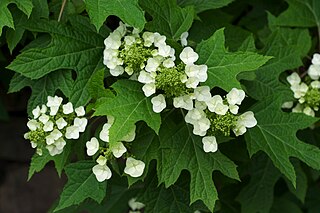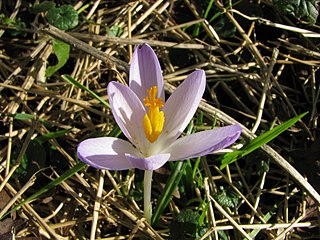
Actaea racemosa, the black cohosh, black bugbane, black snakeroot, rattle-top, or fairy candle, is a species of flowering plant of the family Ranunculaceae. It is native to eastern North America from the extreme south of Ontario to central Georgia, and west to Missouri and Arkansas. It grows in a variety of woodland habitats, and is often found in small woodland openings. The roots and rhizomes were used in traditional medicine by Native Americans. Its extracts are manufactured as herbal medicines or dietary supplements. Most dietary supplements containing black cohosh are not well-studied or recommended for safe and effective use in treating menopause symptoms or any disease. In contrast, some herbal medicinal products containing black cohosh extract hold a marketing authorization in several states of the European Union and are well-studied and recommended for safe and effective use for the relief of menopausal symptoms such as hot flushes and profuse sweating attacks. Such differentiation between the product types seems to be important.

Actaea, commonly called baneberry, bugbane and cohosh, is a genus of flowering plants of the family Ranunculaceae, native to subtropical, temperate and subarctic regions of Europe, Asia and North America.

Lobularia maritima is a species of low-growing flowering plant in the family Brassicaceae. Its common name is sweet alyssum or sweet alison, also commonly referred to as just alyssum.

Hydrangea quercifolia, commonly known as oakleaf hydrangea or oak-leaved hydrangea, is a species of flowering plant in the family Hydrangeaceae. It is native to the southeastern United States, in woodland habitats from North Carolina west to Tennessee, and south to Florida and Louisiana. A deciduous shrub with white showy flower heads, it is grown as a garden plant, with numerous cultivars available commercially.

Salvia splendens, the scarlet sage, is a tender herbaceous perennial plant native to Brazil, growing at 2,000 to 3,000 m elevation where it is warm year-round and with high humidity. The wild form, rarely seen in cultivation, reaches 1.3 m (4.3 ft) tall. Smaller cultivars are very popular as bedding plants, seen in shopping malls and public gardens all over the world.

Actaea spicata, the baneberry or herb Christopher, is a species of flowering plant in the genus Actaea, native from Europe to western Siberia and northern Iran. It is often found on limestone edges and in deciduous woodland; key factors are shade, low competition, and a cool, protected root run.

Pandorea jasminoides, also known by the common names bower of beauty and bower vine, is a species of flowering plant in the family Bignoniaceae and is endemic to eastern Australia. It is a woody climber with pinnate leaves that have three to nine egg-shaped leaflets, and white or pink trumpet-shaped flowers that are red and hairy inside. It is also grown as an ornamental.

Berberis thunbergii, the Japanese barberry, Thunberg's barberry, or red barberry, is a species of flowering plant in the barberry family Berberidaceae, native to Japan and eastern Asia, though widely naturalized in China and North America, where it has become a problematic invasive in many places, leading to declines in species diversity, increased tick habitat, and soil changes. Growing to 1 m tall by 2.5 m broad, it is a small deciduous shrub with green leaves turning red in the autumn, brilliant red fruits in autumn and pale yellow flowers in spring.

Iris chrysographes, the black iris, is a plant species that belongs to the genus Iris. It is native to Southern China and Myanmar (Burma), growing in meadows, streamsides, hillsides and forest margins.

Crocus tommasinianus, the woodland crocus, early crocus, or Tommasini's crocus, is a flower named after the botanist Muzio G. Spirito de Tommasini (1794-1879). It is native to Bulgaria, Hungary, Albania, and the former Yugoslavia. It is often referred to as the early or snow crocus, but these terms are shared with several other species, although C. tommasinianus is amongst the first to bloom. Multiple plants are often called tommies in the horticultural trade.

Hypoestes phyllostachya, the polka dot plant, is a species of flowering plant in the family Acanthaceae, native to South Africa, Madagascar, and south east Asia. The spots often merge into larger areas of colour.

Anemonoides blanda, syn. Anemone blanda, the Balkan anemone, Grecian windflower, or winter windflower, is a species of flowering plant in the family Ranunculaceae. The species is native to southeastern Europe and the Middle East. The specific epithet blanda means "mild" or "charming". The genus name is derived from the Greek word anemos, or wind.

Camellia × williamsii is a cultivar group of hybrid evergreen shrubs that are derived from a crossing of Camellia saluenensis with Camellia japonica. It was originally bred in 1923 at Caerhays Castle in Cornwall by John Charles Williams.

Cyclamen rhodium is a species of flowering plant in genus Cyclamen of the family Primulaceae, native to the Peloponnese, Rhodes, and southwestern Kos. It is a tuberous perennial growing to 10 cm (4 in), with mottled, heart-shaped leaves and pink flowers, darker carmine pink at the base, appearing in spring. Like all cyclamens, the flowers consist of five upswept, reflexed petals.
Actaea arizonica is a species of flowering plant in the buttercup family known by the common name Arizona bugbane. It is endemic to Arizona in the United States, where it occurs in Coconino, Gila, and Yavapai Counties. Like some other species in genus Actaea, this plant was formerly included in the genus Cimicifuga.

Actaea elata is a species of flowering plant in the buttercup family known by the common name tall bugbane. It is native to the Pacific Northwest of North America, where it can be found in British Columbia, Washington, and Oregon.

Rosa'Buff Beauty' is an apricot Hybrid musk rose cultivar, bred by Ann Bentall and introduced into Great Britain in 1939. Bentall and her husband, John Bentall, inherited the rose fields of acclaimed rose breeder, the Reverend Joseph Pemberton after his death in 1926. The rose was awarded the Royal Horticultural Society's Award of Garden Merit in 1993.

Actaea matsumurae, the Kamchatka bugbane or Japanese bugbane, is a species of flowering plant in the buttercup family Ranunculaceae, that is native to Japan, Mongolia and Eastern Russia. Other common names include baneberry, which is also applied to other Actaea species.

Androsace lanuginosa, called the woolly rock jasmine, is a species of flowering plant in the genus Androsace, native to the western Himalaya. It has gained the Royal Horticultural Society's Award of Garden Merit.



















